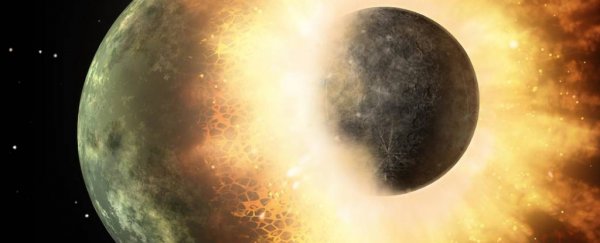The ingredients that created the conditions for life on Earth might not be native to our home planet. According to a new hypothesis, the essential elements for life were carried in on a Mars-sized planet that collided with Earth 4.5 billion years ago.
This hypothetical planet is called Theia, and it's also believed, by some, to be responsible for breaking off a chunk of Earth and sending it careening into space to become our Moon.
But it also, say researchers from Rice University, brought with it the volatile elements such as carbon, nitrogen, hydrogen and sulphur, enabling Earth to spring to life.
Based on what we know, it's unlikely that Earth could have produced the volatiles that fed the atmosphere, hydrosphere and biosphere on its own.
It's long been thought that Earth's volatiles were perhaps carried in on meteorites, called carbonaceous chondrites. These primitive meteorites that bombarded our planet are much richer in volatiles than early Earth (aka Gaia) and other rocky inner Solar System bodies, which is a pretty good supporting case for this hypothesis.
But, according to the researchers, the ratio of these volatiles in the chondrites is off, particularly for one pair of elements. The carbon-nitrogen ratio of the bulk silicate Earth is over 20 times the ratio seen in carbonaceous chondrites.
So the research team embarked on a mission to find out if the volatiles could have been delivered via another method - such as Theia.
In a series of practical experiments using capsules loaded with silicate and alloy mixtures, the team recreated the high-temperature, high-pressure conditions under which Theia's core might have formed. This helped determine at what percentage of sulphur the core might have excluded carbon and nitrogen, leaving them in the planet's bulk silicate.
Armed with this information, the team then ran computer simulations of around one billion different scenarios to determine how Earth got its volatiles.
"What we found is that all the evidence - isotopic signatures, the carbon-nitrogen ratio and the overall amounts of carbon, nitrogen and sulphur in the bulk silicate Earth - are consistent with a moon-forming impact involving a volatile-bearing, Mars-sized planet with a sulphur-rich core," said petrologist Damanveer Grewal.
This does not mean that carbonaceous chondrites did not contribute in some way, but it does indicate that Theia may have contributed the majority - a finding that suggests that a planet may have a better chance of developing life if it undergoes violent collisions.
"From the study of primitive meteorites, scientists have long known that Earth and other rocky planets in the inner Solar System are volatile-depleted," explained geologist Rajdeep Dasgupta.
"But the timing and mechanism of volatile delivery has been hotly debated. Ours is the first scenario that can explain the timing and delivery in a way that is consistent with all of the geochemical evidence."
The team's research has been published in the journal Science Advances.
